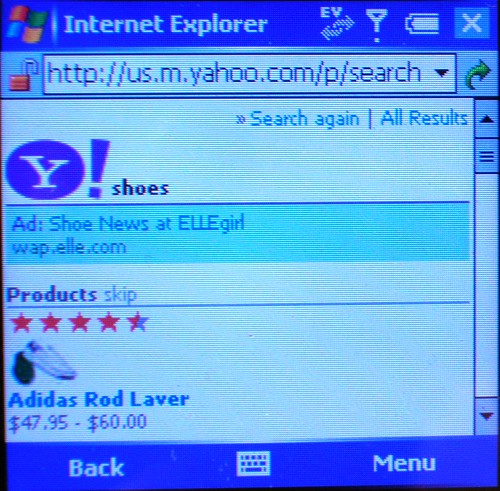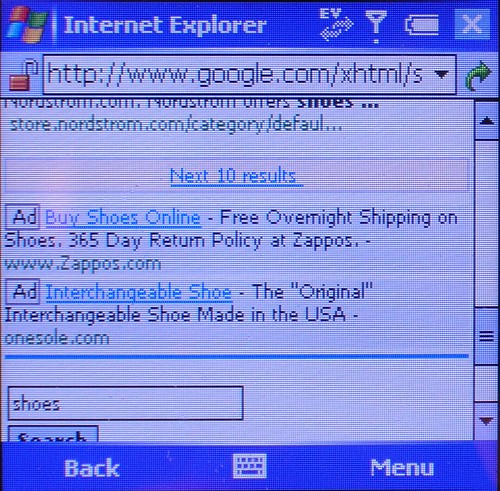Comparing Mobile Ads in Google & Yahoo
Google recently opted-in many of their clients, PPC ads to appear in Google Mobile search results. Yahoo has been offering a small suite of mobile ads for a while now, too, so I thought it,d be interesting to compare their current mobile ad offerings.
Google’s announcement that they would automatically opt-in many of their ads to appear on the mobile platform seems somewhat controversial, since one supposes that a number of advertisers might not notice the change and might be irritated that their ads may now be running on an unanticipated platform. After all, many online retailers who advertise expect that some percentage of users clicking through would be placing online purchases, and mobile devices don’t effectively support transactions yet. Google’s patent for Gpay might pave the way for this, but it hasn’t launched yet.
On one level, Google’s act to opt everyone into this program might not seem all that bad—after all, advertisers are paying for exposure and referrals, too. Greg Sterling reports that Google’s opt-out policy during this trial period is similar to policies Yahoo and Microsoft have used in the past for new/underutilized programs. Since it can be reasonably supposed that CTR on mobile ads is likely relatively low, the cost to advertisers is probably low-to-nil, and Google’s motive is likely just a desire to get research data on mobile ads while also introducing many advertisers to the medium.
A New York Times article quotes Dilip Venkatachari, Product Management Director for AdSense, as saying that “the ads would provide a new source of revenue for publishers and could encourage more online sites to create mobile-focused Web sites. Like most other Google advertising systems, ad prices will be set through an auction and advertisers will pay when a user clicks on its ad.”
So, this should encourage more sites to create mobile friendly versions of their sites? While it’s an idealistic desire, the lack of standardization through the wireless devices pose significant challenges to large companies who are already challenged by making things simultaneously attractive, usable, cross-platform compatible, and optimal for search engines. Not to mention that devices such as the iPhone and Palm Treo for Windows are fast making it possible to view “non-mobilized” sites just fine, reducing any urgency that companies might feel about getting their content to work well for the new environment.
Interactive advertising on mobile is still very new, and there’s little research as to what’s effective and what works for consumers, much less developers. What many analysts are very sure of is that mobile search is likely to be particularly effective for locally-oriented businesses. As Paul J. Bruemmer reports, “While local search marketing is well established, local-mobile search marketing is barely getting started.”
Paul further voices a concern that many have expressed about the advent of ads on phones, a “General intolerance of advertising messages on a personal device.” At least thus far, I’m not hearing a lot of consumer complaints about this yet, perhaps because the ads are not all that obtrusive so far, and perhaps because internet users have already become so accustomed to seeing contextual ads.
For instance, check out these ads I found in Google when doing a search for “florists in Boston” on my Treo running Windows and Internet Explorer:

The ads are located down at the bottom of the search results, and they,re clearly labeled “Ad”, so I don’t find them all that annoying. I have seen one ad appear at the top of Google Mobile SERPs before, but it seems to be a very infrequent position for now.
Notice the ad with the URL that appears to be Google-hosted? I wonder if that’s one of the mobile landing pages that Google states that they may “adapt” for users who click through? This seems particularly odd to me, and it looks like the sort of thing where Google ought to spell out under what circumstances they,ll choose to automatically generate a landing page to “enhance” the user-experience. This seems very controversial to me, because Google is likely charging advertisers when they click through to those generated landing pages, and advertisers may not realize this, causing them to misinterpret effectiveness of apparent conversion rates.
Now, Yahoo provides advertisers with the ability to purchase similar mobile-friendly pages which I believe are intended for this very purpose, but I don’t think they automatically generate a page in the way that Google does—it’s voluntary. For instance, check out these ads for “shoes” from Yahoo Mobile:

When you click on a mobile ad in Yahoo, they provide an optimized mobile landing page. Here’s one that came up for me when I clicked on a Teleflora ad:

In some cases, Google is choosing to dump users onto the landing pages of the advertiser. For instance, here are ads for a “shoes” search in Google Mobile:

And when you click on the ad for Zappos, you get dumped onto their homepage which is not intended for mobile users:

I’m not sure why Google would land a user onto the graphic-intensive Zappos page in this case, instead of using their optimized mobile landing page. Perhaps Google Mobile didn’t think I needed it, since I’m running on a flavor of Internet Explorer? More likely, I’m supposing if the advertiser’s existing landing page includes a phone number, as every page on the Zappos site does, Google may conditionally choose not to automatically generate a more pared-down mobile landing page.
If you’re interested in seeing how your landing page or webpage might be automatically adapted by Google to appear for mobile users, check it out through this interface: https://google.com/gwt/n
Just from observation, Yahoo’s Mobile Ad Service appears broader and more robustly envisioned, allowing a variety of ad types for mobile, including Display Ads, Search Ads, and Video Ads. Yahoo’s promo copy reads “…click through to a promotional site, enable the consumer to find or call a store directly, offer a coupon, send an SMS message—the options keep expanding. If you don’t have a promotional site to link to, Yahoo can create one to your specifications.”
Since Mobile Search and Local Mobile Search are still relatively virgin marketing territories, Google can be forgiven some early program gaffes. But, online marketers may want to go and opt-out some of their current campaigns from running automatically in the mobile end since it could obscure some of their conversion data, particularly if the ads are intended to primarily drive online transactions. It would be better to set up separate campaigns with separate reporting and check to see if an optimal mobile landing page can be associated with the ad.
Also, for mobile ads, be aware that there’s theoretically greater potential for click-fraud. As I earlier outlined in “A Thorny Issue: Detecting Mobile Search Click-Fraud“, invalid clicks may be a lot harder to identify for mobile ads.





